Hiding Earthquakes from dense monitoring networks
Point of contact: Petros Bogiatzis
Accurate and complete cataloguing of aftershocks is essential for a variety of purposes, including the estimation of the mainshock rupture area, the identification of seismic gaps, and seismic hazard assessment. However, immediately following large earthquakes, the seismograms recorded by local networks are noisy, with energy arriving from hundreds of aftershocks, in addition to different seismic phases interfering with one another. This causes deterioration in the performance of detection and location of earthquakes using conventional methods such as the S-P approach. This is demonstrated by results of back-projection analysis of teleseismic data (Kiser and Ishii, 2012) showing that a significant number of events are undetected by the Japan Meteorological Agency, within the first twenty-four hours after the Mw9.1 Tohoku–oki, Japan earthquake. The spatial distribution of the hidden events is not arbitrary. Most of these earthquakes are located close to the trench, while some are located at the outer rise. Furthermore, there is a relatively sharp trench-parallel boundary separating the detected and undetected events.
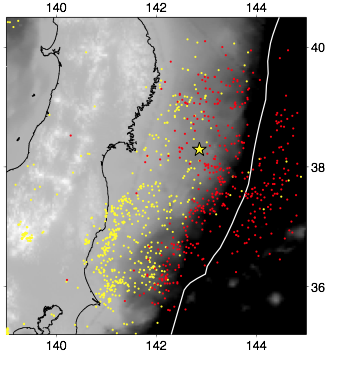 |
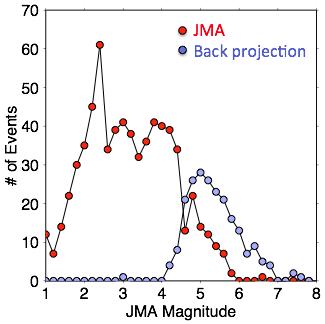 |
Figure 1: Left:Yellow dots correspond to the aftershocks in JMA catalog within the first 24-hours after the March 11, 2012 Mw 9.1 Tohoku–Oki earthquake (yellow star). Red dots correspond to aftershocks observed from continuous back-projection and not included in JMA catalogue. Right: Magnitude distribution of detected - undetected events (more about back-projection results for Tohoku-oki earthquake here).
Forward Experiments
We investigate the cause of these hidden earthquakes using forward modeling. We created a simple velocity model: A high velocity subducting slab on a PREM velocity background. Low velocity zone on top of the subducting plate at the interface with the overriding plate. The calculation of ray paths for various source locations and take-off angles with the “shooting” method show that shadow zones develop for some event locations. The velocity structure defocuses the seismic energy from shallow earthquakes located near the trench and makes the observation of P and S arrivals difficult at stations situated on mainland Japan.

Figure 2: Ray paths calculated with “shooting” method for various source locations (lower panel) and the corresponding number of rays arriving at the surface (top panel). When a source is located near the trench (d), a shadow zone develops for distances > 200 km.
|
Wave propagation simulations confirm these results. Our forward calculations also show that the probability of detection is sensitive to the depth of the event. Shallower events near the trench are more difficult to detect than deeper earthquakes that are located inside the subducting plate for which the shadow-zone effect diminishes (Fig. 3). The modeling effort is expanded to include three-dimensional structure in velocity and intrinsic attenuation to evaluate possible laterally varying patterns. Right: Cross-section of the subduction model that shows different instances of compressional waves propagation. Left column corresponds to a deep source with epicenter near trench, and right column to a shallow source with the same epicenter. The energy arriving at the surface between the two sources differs significantly. Notice also the energy trapped on the high-velocity slab but also in the low-velocity layer, both acting as wave-guides. |
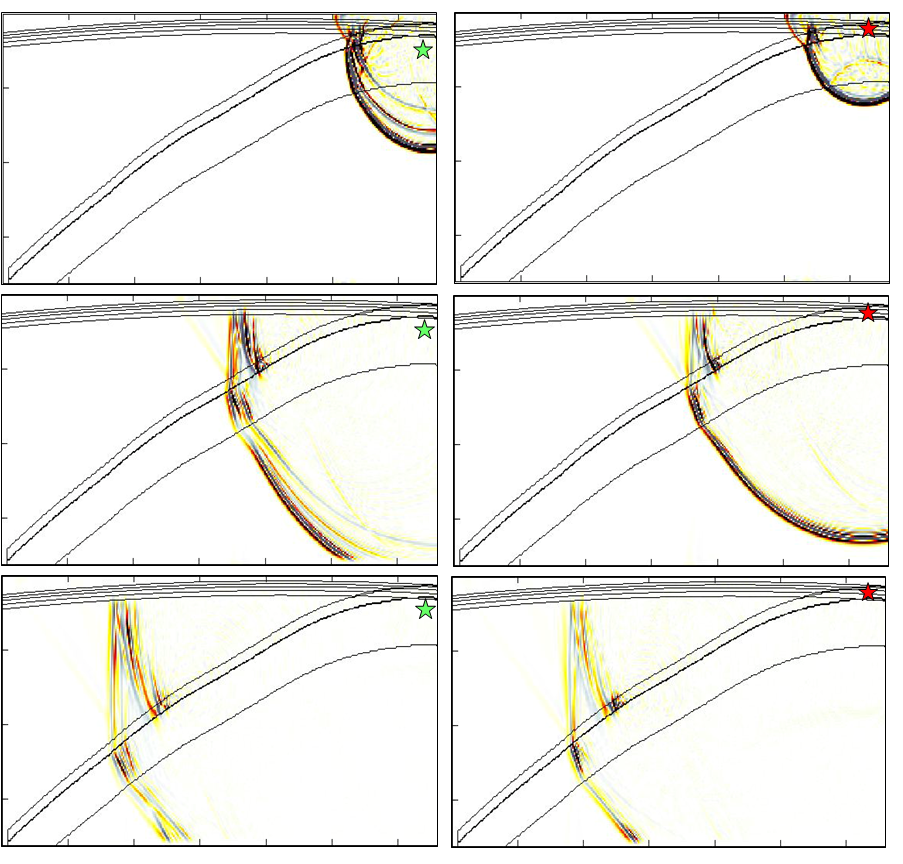
|
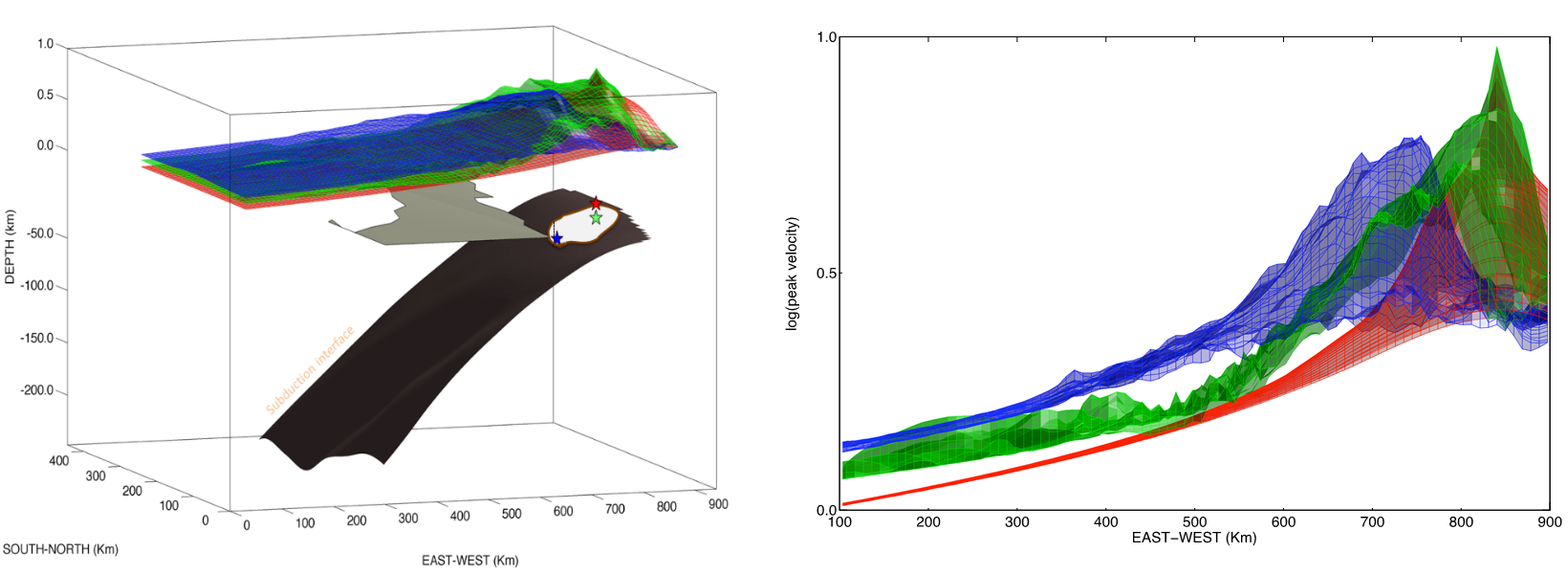
Figure 3: Results from compressional wave propagation simulations. The logarithm of the peak-velocity distribution for 3 different source locations is shown. The source that is located away from the trench (blue) exhibits the largest amplitudes over Japan mainland. The energy from the shallow source on the trench (red) rapidly drops with the horizontal distance. In contrast, the energy of the slightly deeper source at the trench attenuates less and manages to reach the mainland.
Shallow vs. Deeper events
Our forward calculations show that the probability of detection is sensitive to the depth of the event. Shallower events near the trench are more difficult to detect than deeper earthquakes that are located inside the subducting plate for which the shadow-zone effect diminishes. Additionally, the 3D structure and the geometry of the slab, create complex patterns of focusing-defocusing energy.
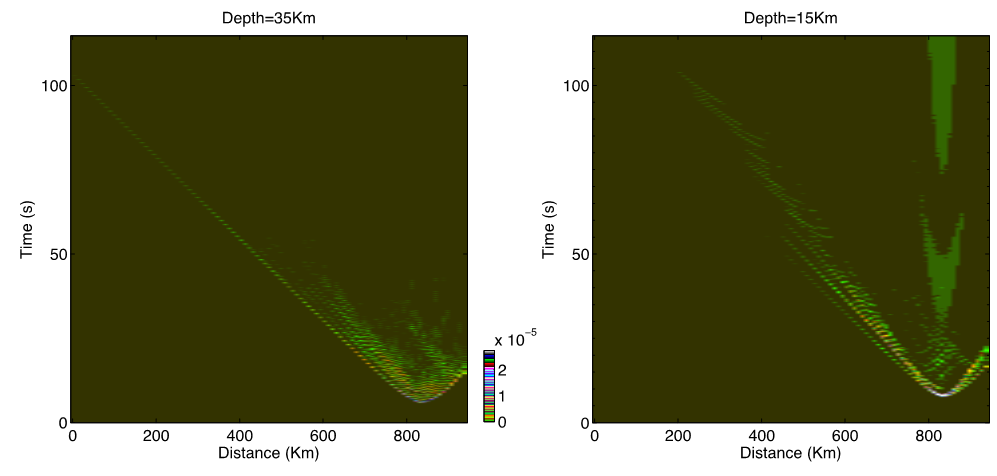 |
Figure 4: Synthetic seismograms of the Vertical component of the compressional wave velocity for two sources with the same epicenter but different focal depths. The energy of the deep event is detectable at greater distances, however, the energy from the shallow event (b) attenuates rapidly.
Summary